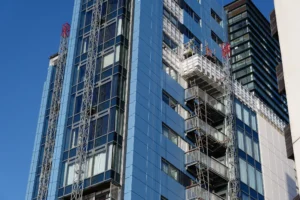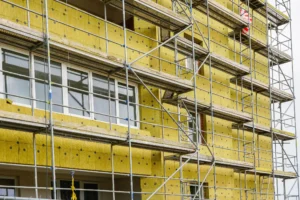The façade and cladding sector is one of the most dynamic and multidisciplinary areas within modern construction. It combines design precision, materials science, sustainability, and safety — all within an evolving regulatory landscape. Whether you’re an engineer, project manager, or trades professional, façades offer a variety of rewarding and technically engaging career paths. Here’s a look inside the sector: the roles, the skills, and how to build a long-term career in the façade industry.
1) The façade sector at a glance
Façades represent the interface between architecture, engineering, and environmental performance. Every modern building — from residential towers to hospitals and airports — relies on high-performing façade systems to deliver safety, comfort, and energy efficiency.
The sector spans design, fabrication, installation, inspection, and maintenance, involving a range of disciplines that together form one of construction’s most technically advanced ecosystems.
The UK façade and cladding market alone is valued at £3–4 billion annually, and demand continues to rise thanks to ongoing retrofit, recladding, and net-zero initiatives.
2) Key roles across the façade lifecycle
| Stage | Typical Roles | Core Responsibilities |
|---|---|---|
| Concept & Design | Façade Engineer, Designer, CAD Technician | Structural analysis, thermal modelling, material specification, coordination with architects |
| Manufacturing & Supply Chain | Fabrication Technician, QA/QC Inspector, Production Planner | Offsite assembly, quality control, materials logistics |
| Project Delivery & Installation | Site Supervisor, Project Manager, Cladding Installer | On-site assembly, sequencing, installation quality, safety management |
| Compliance & Testing | Fire Engineer, Testing Technician, Building Control Officer | Fire safety testing (BS 8414), documentation, regulatory compliance |
| Maintenance & Remediation | Surveyor, Façade Consultant, O&M Technician | Condition assessments, recladding, defect diagnosis, long-term performance monitoring |
Each stage demands collaboration between architects, engineers, contractors, and regulators — meaning communication and coordination skills are just as important as technical expertise.
3) The skills employers value most
⚙️ Technical competence
A strong grasp of structural design, materials behaviour, and thermal performance is fundamental. Knowledge of systems such as curtain walling, rainscreen cladding, and glazed façades is especially valuable.
🔥 Fire safety awareness
Since the Grenfell tragedy, understanding of fire testing, cavity barriers, and material certification is critical across all roles. Even non-engineering professionals are expected to demonstrate basic competence in fire safety principles.
🧠 Digital fluency
The façade sector is becoming increasingly digital: BIM coordination, 3D modelling, and data-driven inspection records (to satisfy the Golden Thread requirement) are now standard.
🤝 Communication and teamwork
Façades bring together multiple disciplines — architects, fabricators, and contractors. Strong coordination and stakeholder management are vital to successful delivery.
📋 Compliance and documentation
Accurate record-keeping, testing evidence, and traceability are non-negotiable. Employers value professionals who combine technical skill with meticulous attention to compliance detail.
4) Typical qualifications and backgrounds
| Role Type | Common Qualifications / Pathways |
|---|---|
| Façade Engineer | MEng/BEng Civil, Structural, or Façade Engineering; MSc Building Envelope Design |
| CAD / BIM Technician | HNC/HND in Design Engineering; Revit/AutoCAD certification |
| Site Manager / Supervisor | NVQ Level 6 in Construction Management; SMSTS/SSSTS |
| Installer / Cladder | NVQ Level 2–3 in Rainscreen/Cladding Installation; CSCS Card |
| Fire Engineer / Compliance | Degree in Fire Engineering or Fire Safety Management; IFE membership |
| Surveyor / Consultant | RICS or CIOB pathway with façade specialism |
| Project Manager | APM, PRINCE2, or similar project controls certification |
There are also increasing numbers of graduate schemes and apprenticeships specifically dedicated to façade design and engineering — reflecting the industry’s growing demand for specialist talent.
5) Career pathways and progression
A typical career might begin as a CAD Technician or Graduate Engineer, progressing into a Façade Engineer or Project Coordinator role after 2–4 years. From there, professionals can move into:
-
Design Management (leading multi-discipline coordination)
-
Project Delivery (site or operations leadership)
-
Technical Consultancy (compliance and performance advisory)
-
Senior Leadership (Associate Director / Technical Director roles)
Specialisation is also common: some engineers focus on fire performance, others on sustainability or digital design.
The façade industry rewards technical depth, attention to detail, and long-term commitment to learning.
6) Why the sector is attracting new talent
Several trends make façades one of construction’s most future-proof disciplines:
-
High demand for skilled professionals — particularly in recladding and retrofit.
-
Strong sustainability alignment — façade design directly impacts energy efficiency.
-
Diverse entry routes — from apprenticeships to degree-level engineering.
-
Global mobility — skills are transferable across regions due to standardised systems and regulations.
-
Project pride — façade professionals often work on landmark buildings that define city skylines.
For professionals seeking purpose-driven work that blends design, technology, and sustainability, façades offer a clear career home.
7) Advice for candidates
-
Build a technical foundation. Understanding materials, loads, and regulations is key.
-
Stay compliant. Keep up to date with fire and safety legislation.
-
Get digital. BIM coordination and 3D visualisation skills enhance employability.
-
Document your work. Employers value detailed project records showing your impact on performance and safety.
-
Engage with industry bodies. Join organisations like CWCT, Society of Façade Engineering (SFE), or CIBSE for CPD and networking.
🌱 Green Carbon Talent: Your Partner in Façade Careers
As Green Carbon Talent expands into façades and building envelope recruitment, we’re helping professionals and employers navigate this fast-evolving sector. From graduate engineers to project leaders, we connect people with the expertise to design, deliver, and maintain the façades shaping tomorrow’s built environment.


